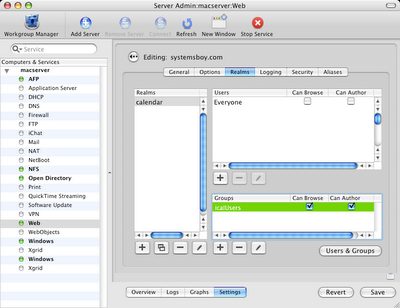So a lot of people are familiar with my articles on publishing iCal calendars to the 'net with box.net. But it turns out that I also have to provide iCal publishing for staff on our internal network, and I do this using a Mac OS X server. Recently, after rebuilding my server, I had some problems with it and had to set it all up again after not having done it in quite some time. It's pretty easy, but there's one snag I got hung up on. We'll get to that in a minute. But first let's run through the steps to set this up.
First and foremost, setting up iCal publishing on Mac OS X Server requires the web server to be running. This can easily be done with the flick of a switch in the Server Admin application. But before we start the service, let's make all our settings. The first thing we need to do is set the root folder for our site. Now in my situation I'm not actually doing any web serving. All I'm doing is calendar serving, and only on our internal network, and that's all I'll describe here. The standard site root folder in Mac OS X Server is /Library/WebServer/Documents. To make things a bit cleaner and easier I'll put all my calendars in a subfolder of this called "calendar," and since that's all I'm serving I'll make that my site root: /Library/WebServer/Documents/calendar. I've given my site a name — systemsboy.com — and manually set the IP address. Otherwise I've left everything alone.
 Server Admin: General Web Settings
(click image for larger view)
Server Admin: General Web Settings
(click image for larger view)Next up we want to set some options. WebDAV is, of course, key to all this. Without it the calendars can't be served in a form we like. So turn on WebDAV. I've also left Performance Caching on and turned everything else off. Again, this is just for serving calendars.
Server Admin: Web Options
(click image for larger view)
Finally, we need to set up our "realm" which is a place where WebDAV/calendar users can share files. To do this, first add a realm to the first box on the left there by clicking the big plus sign beneath it. Give the realm a name, and give it the path to the calendar folder we set as our site root. I am just using "Basic" authentication as this is only going on our internal network and security isn't a big concern in this instance. Once your realm is set up, save the changes and then add some users or a group to the boxes to the right of the realm box. In my setup I added a group called "icalusers" which contains all the users who need to and are permitted to share calendars. I've set the group to be allowed to browse and author. This is necessary for users to read from and publish to the server respectively. You can do the same with individual users in the upper box. Once you've got that set up, save your changes and start the web service.

Server Admin: Realms
(click image for larger view)
That's pretty much it, except for one crucial thing: permissions. I always seem to forget this, but permissions on the calendar folder must be properly set. Since WebDAV permissions are handled by the web server, the proper way to set this up is to give the user that runs the web server ownership and read/write access to the calendar folder. In most cases that user is called www. It's probably a good idea to give group ownership over to the www user as well. So before this will work you need to run:
sudo chown www:www /Library/WebServer/Documents/calendar
To set the ownership to www, and:
sudo chmod 770 /Library/WebServer/Documents/calendar
To give said user full access to the folder.
[Updated to reflect user comments. See note at end of article for details. -systemsboy]
Once that's done, just start the web service in the Server Admin application by selecting the "Web" service in the far left-hand column and pressing the big green "Start Service" button in the app's toolbar. You should now be able to publish and subscribe to calendars on your Mac OS X Server from iCal. The publishing URL for my example would look something like this:
http://systemsboy.com
And subscribing to the calendar, where "Birthdays" is the calendar name, would look like:
http://systemsboy.com/Birthdays.ics
Simple, right? Yeah, I thought so too. Just watch those permissions! Bites me every time.
NOTE:
I had originally reported that permissions for the calendar folder should be set to 777. A couple readers pointed out in the comments section that this is not the case. I have edited this article to reflect their suggestions which are a much better solution than my original one.
Thanks, guys, for pointing that out! Really good to know!




